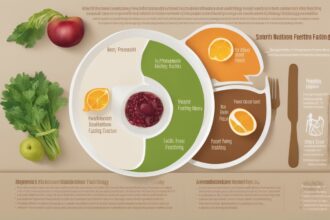Hey there, fasting enthusiasts! If you’ve just completed a fast—whether it’s intermittent fasting, a prolonged water fast, or a juice cleanse—you’re probably wondering, “How to refeed without undoing all my hard work?” Breaking a fast is just as critical as the fasting itself. Done right, refeeding can enhance the benefits of your fast, support recovery, and prevent discomfort or health risks. Done wrong, it can lead to digestive issues, energy crashes, or even serious conditions like refeeding syndrome. In this comprehensive guide, we’ll dive into practical refeeding strategies, backed by science, to help you transition back to regular eating with ease. Let’s explore how to nourish your body post-fast and keep those health gains intact!
What Is Refeeding, and Why Does It Matter?
Refeeding is the process of reintroducing food after a period of fasting or severe calorie restriction. When you fast, your body shifts into a state of conservation—metabolism slows, digestive processes take a backseat, and your system adapts to limited fuel. Suddenly flooding your body with food can shock it, leading to issues like bloating, nausea, or more severe complications. The goal of refeeding is to gently wake up your digestive system and replenish nutrients without overwhelming it. According to research, improper refeeding can pose risks, especially after prolonged fasts, due to electrolyte imbalances and metabolic stress (Friedli et al., 2017). So, knowing how to refeed safely is non-negotiable for anyone practicing fasting as part of their wellness routine.
Understanding the Risks of Poor Refeeding
Before we get into the “how,” let’s talk about the “why.” Refeeding isn’t just about feeling good—it’s about staying safe. One of the most serious risks is refeeding syndrome, a potentially life-threatening condition caused by rapid shifts in electrolytes like potassium, magnesium, and phosphate when food is reintroduced too quickly. This is especially common after extended fasts or in individuals with malnutrition (Mehanna et al., 2008). Symptoms can include weakness, confusion, and even heart issues. Beyond this, less severe but still unpleasant side effects like bloating, cramping, or energy spikes and crashes can occur if you dive into heavy meals right away. The key takeaway? A thoughtful post-fast nutrition plan is essential to avoid these pitfalls.
How to Refeed: Key Principles for Success
So, how to refeed in a way that supports your body? The process should be gradual, intentional, and tailored to the length and type of fast you’ve completed. Here are some core principles to guide your refeeding after fasting, ensuring you ease back into eating without stress or strain.
- Start Small: Begin with small portions to avoid overwhelming your digestive system. Think a few spoonfuls of broth or a small piece of fruit rather than a full meal.
- Prioritize Hydration: Your body needs fluids to kickstart digestion. Sip water, herbal teas, or electrolyte solutions before and during refeeding.
- Choose Easy-to-Digest Foods: Opt for simple, nutrient-dense options like soups, steamed veggies, or soft fruits to minimize digestive strain.
- Go Slow with Calories: Gradually increase calorie intake over days, not hours, especially after longer fasts.
- Listen to Your Body: Pay attention to how you feel—stop if you experience discomfort, and adjust accordingly.
Refeeding Strategies Based on Fast Duration
Not all fasts are created equal, and neither are the refeeding approaches. Whether you’ve done a 16-hour intermittent fast or a multi-day water fast, your safe refeeding tips will vary. Let’s break it down by duration to give you a clear roadmap for how to refeed effectively.
For short fasts (12–24 hours), like those in intermittent fasting, refeeding can be relatively straightforward. Your body hasn’t been in a deep state of deprivation, so you can often return to normal eating with a light meal. Think a small salad with lean protein or a smoothie. Research suggests that short fasts don’t significantly disrupt electrolyte balance, so risks are minimal (Tinsley & La Bounty, 2015).
For medium fasts (1–3 days), such as a weekend juice cleanse, you’ll need a bit more caution. Start with liquids like vegetable broth or diluted juice for the first few hours, then introduce soft foods like mashed avocado or oatmeal. Avoid heavy fats and proteins initially, as your digestive enzymes need time to ramp up (Johnstone, 2015).
For prolonged fasts (3+ days), the stakes are higher. Refeeding should span several days, beginning with very small amounts of easily digestible foods—think bone broth or small portions of cooked vegetables. Medical supervision is often recommended for fasts exceeding five days due to the risk of refeeding syndrome (Friedli et al., 2017). Gradually reintroduce complex carbs and proteins over a week, keeping portions tiny at first.
Best Foods for Refeeding After Fasting
Choosing the right foods is a cornerstone of how to refeed successfully. The focus should be on nutrient-dense, gentle options that provide essential vitamins, minerals, and energy without taxing your system. Here’s a handy list of foods to prioritize during your post-fast recovery phase.
- Bone Broth or Vegetable Broth: Rich in electrolytes and easy on the stomach, broth is a perfect first food after any fast.
- Steamed or Boiled Vegetables: Options like zucchini, carrots, or spinach are gentle and provide vital nutrients.
- Soft Fruits: Bananas, applesauce, or melons offer natural sugars for energy and are easy to digest.
- Small Amounts of Lean Protein: After a day or two, introduce proteins like eggs or fish to rebuild muscle tissue.
Avoid processed foods, heavy fats, and sugary treats during the initial refeeding phase. These can spike blood sugar, cause inflammation, or lead to digestive distress. Studies show that a diet rich in whole, unprocessed foods during refeeding supports better metabolic recovery (Mattson et al., 2017).
Common Mistakes to Avoid When Refeeding
Even with the best intentions, it’s easy to slip up when figuring out how to refeed. I’ve seen plenty of fasters dive into a big meal out of excitement or hunger, only to regret it later. Let’s cover some common missteps so you can sidestep them during your breaking a fast guide journey.
First, don’t rush it. Eating too much too soon is the number one mistake. Your stomach shrinks during a fast, and overloading it can cause pain or nausea. Second, steer clear of caffeine and alcohol right after fasting—they can dehydrate you and irritate your gut. Third, don’t ignore electrolytes. Replenishing sodium, potassium, and magnesium is crucial, especially after longer fasts, to prevent imbalances (Mehanna et al., 2008). If you’re unsure, consider a balanced electrolyte drink or consult a healthcare provider. Lastly, don’t skip the planning. A structured refeeding plan helps you stay on track and avoid impulsive eating decisions.
Refeeding isn’t just a physical process—it’s mental too. After days of discipline, the urge to “reward” yourself with a cheat meal can be strong. I get it; I’ve been there. But trust me, patience pays off. Stick to your post-fast nutrition plan, and you’ll feel energized and satisfied without the guilt or discomfort.
In wrapping up, mastering how to refeed is a game-changer for anyone incorporating fasting into their lifestyle. It’s not just about eating again; it’s about nourishing your body with intention, respecting the reset you’ve achieved, and protecting your health. By starting slow, choosing the right foods, and tailoring your approach to your fast’s duration, you can make refeeding a seamless part of your wellness journey. Remember, fasting and refeeding are two sides of the same coin—both require mindfulness and care. So, take these refeeding strategies to heart, experiment with what works for you, and don’t hesitate to seek professional advice if you’re tackling a longer fast. Here’s to breaking your fast the right way and feeling amazing every step of the journey!
References
- Friedli, N., Stanga, Z., Sobotka, L., Culkin, A., Kondrup, J., Laviano, A., … & Schuetz, P. (2017). Revisiting the refeeding syndrome: Results of a systematic review. Nutrition, 35, 151-160. https://doi.org/10.1016/j.nut.2016.05.016
- Mehanna, H. M., Moledina, J., & Travis, J. (2008). Refeeding syndrome: What it is, and how to prevent and treat it. BMJ, 336(7659), 1495-1498. https://doi.org/10.1136/bmj.a301
- Johnstone, A. (2015). fasting for weight loss: An effective strategy or latest dieting trend? International Journal of Obesity, 39(5), 727-733. https://doi.org/10.1038/ijo.2014.214
- Tinsley, G. M., & La Bounty, P. M. (2015). Effects of intermittent fasting on body composition and clinical health markers in humans. Nutrition Reviews, 73(10), 661-674. https://doi.org/10.1093/nutrit/nuv041
- Mattson, M. P., Longo, V. D., & Harvie, M. (2017). Impact of intermittent fasting on health and disease processes. Ageing Research Reviews, 39, 46-58. https://doi.org/10.1016/j.arr.2016.10.005






